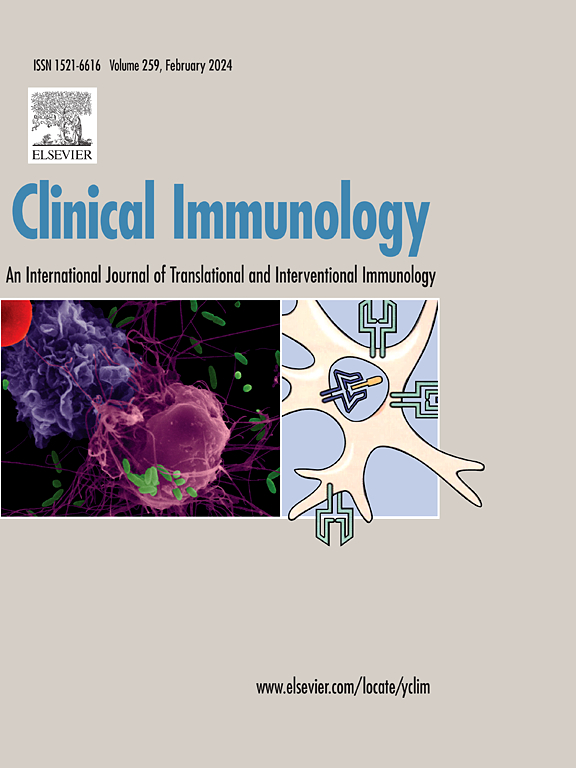CD14+CD11c+HLA-II−单核细胞与强直性脊柱炎的破骨细胞发生有关
IF 3.8
3区 医学
Q2 IMMUNOLOGY
引用次数: 0
摘要
异常单核细胞参与强直性脊柱炎(AS)的发病机制。我们研究了单核细胞亚群失衡与AS骨破坏之间的关系。与对照组相比,AS患者外周血中CD14+CD11c+HLA-II+单核细胞增加,CD14+CD11c+HLA-II+单核细胞减少。LPS刺激促进CD14+CD11c+HLA-II -单核细胞向CD14+CD11c+HLA-II+单核细胞的转变,增强了前者促进CD4+ T细胞增殖的能力。微RNA-seq分析表明,AS CD14+CD11c+HLA-II−单核细胞参与破骨细胞分化,并过量产生可溶性破骨细胞因子CSF-1。在40例AS患者中,CD14+CD11c+HLA-II -单核细胞与加拿大脊椎关节炎研究协会(SPARCC) MRI炎症评分(r = 0.336, P = 0.034)和骨侵蚀评分(r = 0.423, P = 0.007)呈正相关,与强直评分呈负相关(r = - 0.346, P = 0.029)。相反,CD14+CD11c+HLA-II+单核细胞表现出相反的相关性。我们的研究结果表明,CD14+CD11c+HLA-II -单核细胞的扩增有助于AS的骨侵蚀,可能通过csf -1驱动的破骨细胞分化介导。本文章由计算机程序翻译,如有差异,请以英文原文为准。
CD14+CD11c+HLA-II− monocytes are identified to be associated with osteoclastogenesis in ankylosing spondylitis
Abnormal monocytes are involved in the pathogenesis of ankylosing spondylitis (AS). We investigated the association between an imbalance of monocyte subpopulations and bone destruction in AS. Compared to controls, AS patients exhibited increased CD14+CD11c+HLA-II− monocytes and decreased CD14+CD11c+HLA-II+ monocytes in peripheral blood. LPS stimulation promoted a shift from CD14+CD11c+HLA-II− monocytes toward CD14+CD11c+HLA-II+ monocytes, enhancing the former's capacity to promote CD4+ T cell proliferation. Micro RNA-seq analysis indicated that AS CD14+CD11c+HLA-II− monocytes were involved in osteoclast differentiation and overproduced soluble osteoclastogenic cytokine CSF-1. In 40 AS patients, evaluated CD14+CD11c+HLA-II− monocytes correlated positively with Spondyloarthritis Research Consortium of Canada (SPARCC) MRI inflammation score (r = 0.336, P = 0.034) and bone erosion score (r = 0.423, P = 0.007), but inversely with ankylosis score (r = −0.346, P = 0.029). Conversely, CD14+CD11c+HLA-II+ monocytes showed the opposite correlation. Our findings demonstrate that expansion of CD14+CD11c+HLA-II− monocytes contribute to bone erosion in AS, potentially mediated through CSF-1-driven osteoclast differentiation.
求助全文
通过发布文献求助,成功后即可免费获取论文全文。
去求助
来源期刊

Clinical immunology
医学-免疫学
CiteScore
12.30
自引率
1.20%
发文量
212
审稿时长
34 days
期刊介绍:
Clinical Immunology publishes original research delving into the molecular and cellular foundations of immunological diseases. Additionally, the journal includes reviews covering timely subjects in basic immunology, along with case reports and letters to the editor.
 求助内容:
求助内容: 应助结果提醒方式:
应助结果提醒方式:


